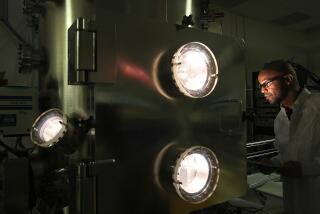Engineers Back in Demand for Aerospace, Defense
- Share via
The job market for engineers in the aerospace and defense fields in the San Fernando Valley area has improved significantly in 1987.
The push comes after last year’s slump, caused in part by the explosion of the space shuttle Challenger as well as concerns that the Gramm-Rudman deficit-reduction bill would trim defense and aerospace spending.
Big hiring campaigns are under way at the Lockheed-California Co. in Burbank and at the Canoga Park-based Rocketdyne division of Rockwell International. Employment is also up somewhat at Hughes Aircraft.
Litton Industries’ units in the Valley report that hiring is stable. And ITT Corp.’s Gilfillan division in Van Nuys said it is eliminating “unnecessary” jobs, mostly through attrition.
Trained Engineers Needed
Jobs that are open tend to be for engineers trained in defense electronics, such as flight control, artificial intelligence, target tracking and telecommunications, said Jeff Pickett, branch manager of the Woodland Hills office of Technisearch International.
Jobs are being filled by skilled veterans as well as those wet-behind-the-ears engineers straight out of college, said Julian Schor, president of Wingate Dunross Inc., a Woodland Hills-based engineering search firm.
Salaries are better than last year, Schor said, with top entry-level candidates getting as much $30,000 to $32,000 a year. Those with five years of experience are getting somewhere between $40,000 to $45,000 a year, he said.
Lockheed-California, a unit of Calabasas-based Lockheed Corp., by far the Valley’s largest employer with approximately 16,000 on its staff, reports it has 1,000 job openings now, nearly a quarter of which are engineering slots.
“We haven’t had a drive like this since the L-1011 push in the late 1960s,” said Andrew Marko, president of the Engineers and Scientists Guild in Burbank, which represents Lockheed engineers. The L-1011, discontinued in 1983, was Lockheed’s last commercial aircraft.
Contract for Fighter Jets
Lockheed attributes the surge to a contract the company snagged in October to build prototype models of the Advanced Tactical Fighter, a supersonic fighter jet for the Air Force. Production of prototypes will begin as early as 1988. Lockheed will probably compete with Northrop for the final production contract.
Lockheed spokesman Nick Durutta said the unit is also hiring engineers for modifications of ongoing programs, such as the P-3 Orion, flown by the U.S. Navy, and the TR-1, a high-altitude reconnaissance plane used by the U.S. Air Force.
Engineers at Rocketdyne, which employs some 7,000, are feverishly incorporating hundreds of design changes into the space shuttle’s main engines in preparation for the next flight, now planned for 1988, said unit spokesman Ed Klodt.
Klodt says hiring is ahead of last year, when the shuttle project was put on hold after the Challenger accident. For example, he said, the group has hired 128 recent college graduates as engineers since January, compared to 55 during the same period in 1986.
Rocketdyne is also hiring engineers to work on small launch rockets such as Atlas and Delta, and on laser optics under a contract that is part of the “Star Wars” space-defense program.
Hughes Aircraft reports stable employment at its Valley facilities, spokesman Mike Murphy said. Hughes’ Missile Systems Group in Canoga Park is awaiting major decisions from the Pentagon this year on whether to go ahead with two advanced air-to-air missile systems.
Sylmar-based Spectrolab, a Hughes unit that makes solar panels for spacecraft, does expect to add about a half dozen engineering jobs this year, increasing its employment to about 175, said spokesman Bill Herman.
Litton Industries, which employs approximately 7,000 in the Valley area, including 3,800 at a Guidance and Control unit in Woodland Hills, has few changes in employment levels this year, said spokesman John Thom.
At ITT Gilfillan, spokesman Brian Eden said its unit is streamlining to cut costs.
“We’re at the point on our projects that we’re passing along the work from engineers to our production people,” he said. The Gilfillan unit makes radar equipment, mostly for military ships.
More to Read
Inside the business of entertainment
The Wide Shot brings you news, analysis and insights on everything from streaming wars to production — and what it all means for the future.
You may occasionally receive promotional content from the Los Angeles Times.










